 The following are the slides and major talking points for Day One at the Competency-Based Education Workshop.
The following are the slides and major talking points for Day One at the Competency-Based Education Workshop.
Feel free to leave questions or suggested resources in comments.
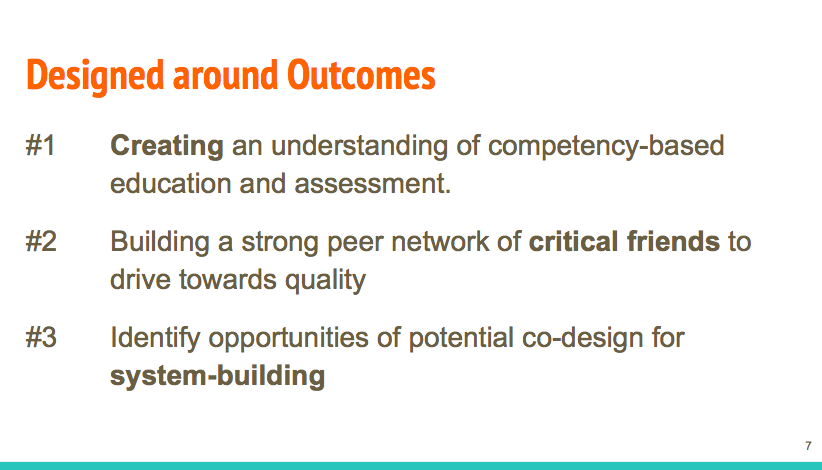
We designed these 2 days around three outcomes.
#1 Creating an understanding of competency-based education and assessment.
#2 Building a strong peer network of critical friends to drive towards quality
#3 Identify opportunities of potential co-design for system-building
I’ve highlighted these three words for a reason. First, if we are successful, you will be creating knowledge for yourselves and as a team. I’m not going to stand here and tell you about competency-based education. I’m not going to talk at you very much. The research on learning tells us that we don’t absorb much by listening. We have to be active learners. That’s why you will be creating or going deeper on your understanding.
Second, the Consortium isn’t just any network. It’s the network leading the way for personalized, competency-based education in Kentucky and that means you have to pay attention to quality. It’s important to build relationships that are strong enough to be critical friends to each other. Ask about each other’s reasonings for design and implementation strategy. Identify under-developed design. Point out when there are red flags where quality problems might develop. If we don’t get to high quality models, this effort will not be able to sustain itself.
Third, there are times when it makes sense for multiple districts and the state work together. It can be more efficient. It can spark greater creativity. And it can lead to system-building that will institutionalize personalization and competency-based education. For example,an excellent example of co-design is the development of six anchor competencies by several districts and the KY Dept of Education. You will be hearing more about later about. Keep your eye out for places where co-design will be beneficial. Share them with your superintendent. David will check in with the superintendents after the meeting to gather ideas

Let’s start working on the 2nd outcome right now and do a bit of preliminary networking. I’m going to list a role and if you fill that role in a district please stand up, look around, say hello to each other…and then sit back down again. Are you a principal? Are you a supt or assistant supt? Do you work in the district administration? Do you focus on curriculum? Do you focus on professional development or instructional coach? Do you focus on special education or any targeted groups of students? Do we have any people who are currently a teacher? …….
A network is made up of lots and and lots of smaller networks. Thus, each of you as individuals are going to be building your own network and together they will create a dynamic Consortium with multiple links. How about each of you commit to finding at least 3 people by the end of the day tomorrow that you personally connect with and that in some way could help you with your work in your district or school.
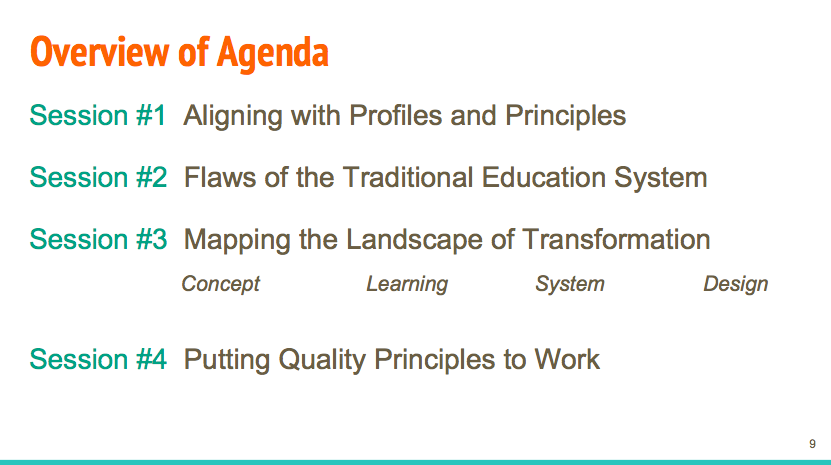
In addition to the three outcomes we used the research on learning to help shape the agenda. Part of this just makes sense because we should always use the research on learning for any type of professional development. We wanted to walk the talk. Participants need to be doing the learning, not the listening. We know that the research on learning and development tell us that we need to link to prior knowledge. Yet, learners are all at different levels with different experiences and knowledge. We know motivation increases when learners have autonomy. So you will have options and if you want to modify or create your own task in any session that is a-okay. We know that to learn we need time for reflection. So after each session there will reflection time.
There is also another related reason to use the research on learning to design the workshop. High quality implementation is the exception and not the rule. I’ve visited so many schools on the path towards competency-based education and there are so many educators thrilled with the set of practices they are putting into place. They’ve rediscovered their sense of purpose. They’ve seen the difference it is making for students. But the school has only implemented a handful of practices. Or they’ve implemented them in ways that still replicate the dynamics of the traditional system.
There are several reasons for this quality problem. Some problems emerge when districts and schools try to move to competency-based education without thinking about personalization. Other problems stem from state policy that reinforce the traditional system.
From what I can tell the biggest reason behind the quality problem is that districts and schools often jump straight into implementation. Let’s do it! We don’t spend enough time understanding Why they make sense and Why aspects of the traditional system inhibit learning.
What we’ve learned during my 8 years at CompetencyWorks is that we don’t spend enough time fixing the cracks in the foundation of the system. We wouldn’t be surprised that a newly remodeled kitchen started to have problems if the foundation of the house was cracked, leaking and moldy. In the same way, if we don’t fix the cracks in the education system, the new practices are going to have problems. It’s just as important to learn about what we need to stop doing as it is to introduce new practices.
The way we fix the cracks is to deeply understand the traditional system, the one we grew up with and the one you have all been working in. Fixing the cracks requires us to deeply understand the research on learning and development so that it can guide us in making really good decisions about what is best for children. This agenda is designed to help you fix the cracks and lay a strong new foundation
We’ve designed four sessions and in each session you will have choices based on where your district and team is. We begin by thinking about what it means to align schools with the graduate profile and the research on learning. In the afternoon we are going to look at the beliefs and characteristics of the traditional system that undermine achievement. In the evening, you can sign up to go to dinner with colleagues from different districts at a local restaurant. Be sure to sign up for one of the dinners and go meet other people. You might arrange a birds of a feather dinner or find people with the same questions or interests as you.
Tomorrow, we start the day with a session that allows you to work closely with your district team to map out where you are and where you want to go. In the afternoon, we’ll look at four quality principles and learn how to use them to help you along the way. Be sure to have skimmed at least one of the case studies that was sent to you and all four of the quality principles.

I know that each of you have your own questions. Let’s call them the burning questions. They reflect your own jobs, your interests, and where you are in your own learning. And we want to make sure you get some insights over the next two days.
Based on those who completed the survey, here are some of your burning questions. Does any one want to share your burning questions? We can’t help each other discover answers without knowing what your questions are.
Remember your job is to help each other answer each other’s questions.
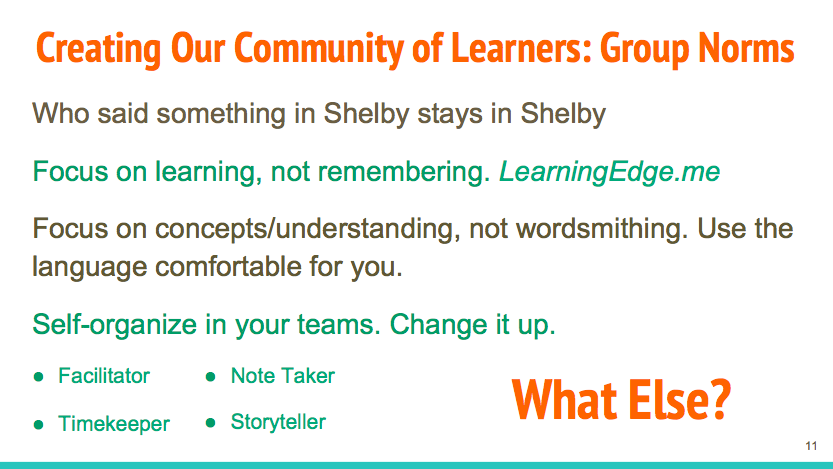
For these two days we are a community of learners. So what norms do we need in our community to support our learning? I’m going to propose 4 to get us started.
- You know the phrase what happens in Las Vegas stays in Las Vegas…well I’m going to modify this a bit…Who said what in Shelbyville stays in Shelbyville. We want to take the insights home with us…and we also want to create safe space for everyone here. Some of this work may be uncomfortable and some of it may produce emotions.
- Focus on learning and not remembering. Everything I say is up at Learning Edge including all the slides. If resources are mentioned I’ll add them there.
- Focus on understanding and not wordsmithing. Different people and districts will use different language. Ask what people mean to understand their perspective.
- Self-organize: We have four sessions and I’m going to ask you to quickly self-organize into 4 roles. The facilitator is responsible for inclusion and soliciting diverse perspectives on topics before moving on. The time keeper will make sure you are progressing. The note taker keeps track of what is agreed upon and the storyteller will present your ideas and share major insights.
What else would you like as a group norm?

I think of learning at conference as the same as blueberry picking. Like my niece Corenna, while you are there you are eating some of the blueberries or discovering new insights, resources and people. But if you don’t have a basket, you can’t bring anything home with you. The Maori culture of New Zealand tells the story of how the god Tane brought three of baskets of knowledge to humans. A basket of knowledge — it’s a powerful image.
So think of this reflection tool as your basket of knowledge to bring home what you are learning.
To get you started there are four compartments in your basket:
- A-ha’s are for new understanding or insights. We often absorb these really quickly and if we can capture them it is more likely we can help other people discover them as well. Take aways are the A-ha’s you want to bring home with your team – or maybe there is something that will be meaningful for a specific colleague
- More questions, follow up and look up is the place where you scribble down additional questions, resources that are mentioned and ideas you want to investigate. You will keep track of your personal inquiry here.
- What is the meaning of personalized, cbe? I’ve been visiting schools for over 8 years and my understanding is still developing. When you hear something that really deepens your understanding grab it.
- Opportunities for co-design: As I mentioned earlier, when you are able to co-design you are able to co-create the new system of education in KY…so it’s not top down. Keep listening for places where co-design would be valuable. Share them with David.
Let’s just review the responsibilities you all have here today. 1) You are responsible for your own learning, if you aren’t getting what you need let DC or me know. 2) Supporting your team members in their learners and building a shared understanding; 3) Meeting people so that you are building your own personal network and 4) Looking for opportunities where two or more districts might co-design or where the state might be a partner.

At CompetencyWorks, with the help of 40 researchers and practitioners, we developed a logic model to help clarify what CBE is. Too often it is described as classroom changes without addressing the more systemic aspects. You can find the link to the paper Levers and Logic Models here.
There are always values, beliefs and external forces that shape any organization including schools. As we shift from the traditional system to this modern system of education we need to be very intentional about the reasons behind our designs and implementation decisions. Some people call this the Big Why’s — why are we emphasizing voice and choice? Why are we moving to multi-age grading? Why are we moving to block schedules? Why are we doubling the time for professional learning communities in the schedule? We need to be very clear on our intention.
The CBE Logic Model starts with knowing what we want students to know and be able to do when they leave your school and district. We talk about this as a graduate profile. It’s usually described as high school graduate but an elementary and middle school should also have a clear idea of their graduate profile as well. Graduate profiles usually have more than the core academic courses required by state policy.
So we are aligning with the graduate profile on one end. The next question is how do we get them there. There are two levers that we want to think about one. The first in the research on learning and development. As much as possible that should be the guide for both design and decision-making during implementation. The other is equity — it requires us to constantly think about how designs and decisions will impact historically underserved students. It requires us to constantly look at ourselves first for bias or patterns of privileging the privileged, or creating disadvantage for the disadvantaged. We created a framework for thinking about equity in competency-based education called Designing for Equity — what’s remarkable is when we wrote the Quality Principles for CBE they are almost identical.
The last part of the logic model is mediating factors. These mediating factors, your local context and who your students are, will influence how you start and aspects of your design. This is why it is hard to create an implementation playbook for districts. You will always need to start on your strengths and create strategies that repair mistrust or other damage developed over the years.
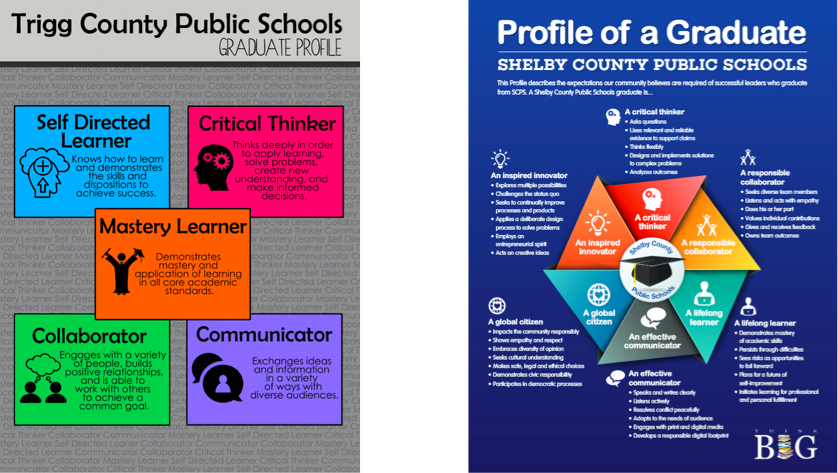
Here are examples of graduate profiles from Shelby and Trigg. My understanding is that most or all of you have developed something similar.
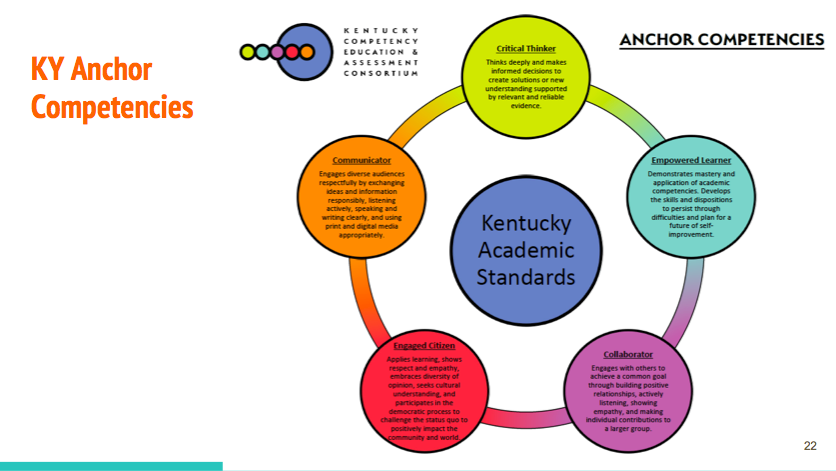
Graduate profiles often include higher order skills and capacities, what KY is calling the anchor competencies: critical thinker, collaborator, communicator, engaged citizen and empowered learner. As members of the consortium, you’ve all committed to using the anchor competencies, although you can use different terms, that were codesigned by several districts.
There are implications for schools when you include these types of skills in your profile. For example, to become critical thinkers all students will need opportunity to work at the high end of the Bloom’s taxonomy, not just the higher achieving students. Teachers may need to develop their capacity to provide instruction and feedback on the steps involved in critical thinking, analysis and evaluation. Empowered learners means that students need to own their learning. This means students will be building skills in growth mindset, self-regulation, metacognition and self-advocacy throughout their time in school. Likewise schools and classrooms will need to design so that there is time for reflection and coaching.
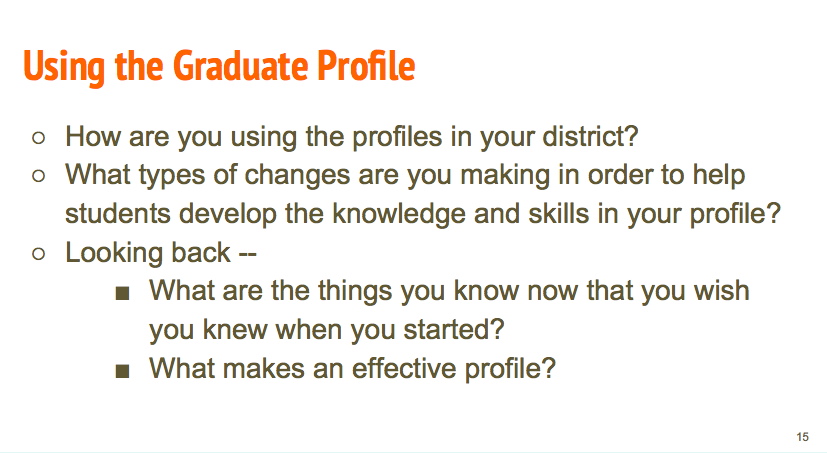
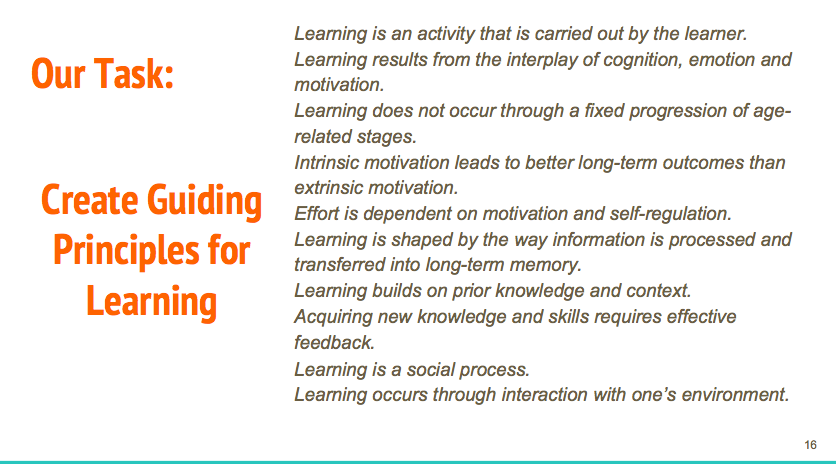
The research on learning and development is huge and it is growing. The research also comes from different domains — some from neuroscience, some from psychology, some from biology. The research tells us how we process and remember information. It tells us about motivation. It tells us about how our emotions shape learning. There is a lot of research that is agreed upon and there are still gaps. For example, we know more about how we process information and much less about how we retrieve it.
If we want to optimize learning in schools then we need to use the research on learning to make decisions. It can inform the design of our schools, the policies and practices we choose and how we implement new practices. It can inform the school culture and management strategies. Many districts short-hand this to say What’s Best for Kids.
Your task is to create a shared understanding of the key research findings on learning and development that might guide a school or district. On your table you will find an envelope marked #1 that has directions (Guiding Principles of Learning) for this task and small cards. Each of the cards has a research finding on it. They represent findings from different fields and from different resources that are marked in parentheses at the end. They have different degrees of specificity. They have different ways of communicating the ideas. There are also blank ones if you want to rewrite one or add a finding.
Your job is to select no more than 10 to create a set of guiding principles for a district or school that will help you think about the design of your personalized, competency-based system. You’ll need to quickly self-organize the four roles of facilitator, time keeper, note taker, and story teller. Spend a few minutes thinking about what makes an effective set of guiding principles. You can always adjust it along the way. Be sure to leave enough time to create a presentation. You can tape them on the paper, write them or be creative and create icons or a drawing.
If you are someone who is already very familiar with this research, we have some challenge work for you. As your team selects the findings, you will pretend you are making recommendations to an audience of your choice– perhaps the school board or to faculty — about the implications of using the graduate profile and the research on learning and development to drive decisions in your school or district. What are the 5-10 most important changes or new capacities you will need to develop?
You’ll have 45 minutes. Remember to self-organize. Remember to leave time at the end to create your presentation.
At the end we’ll have a few of the tables present their guiding principles for teaching. Those of you doing challenge work, we’ll want to hear a couple of your ideas about the implications of the profile and the guiding principles as well.

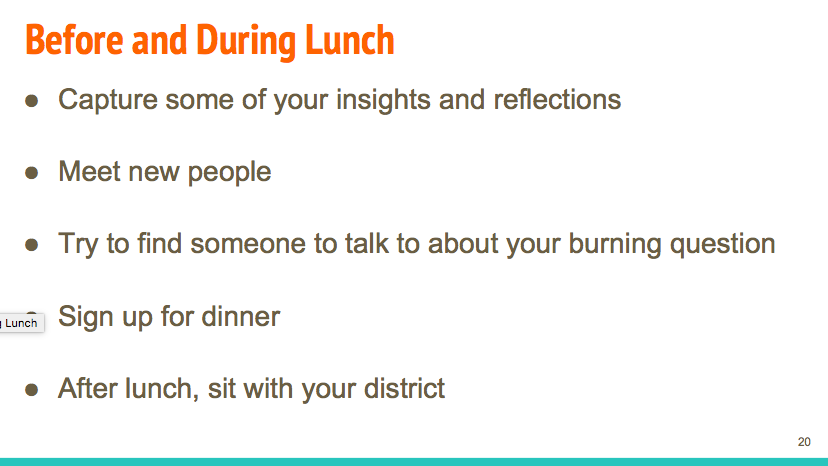

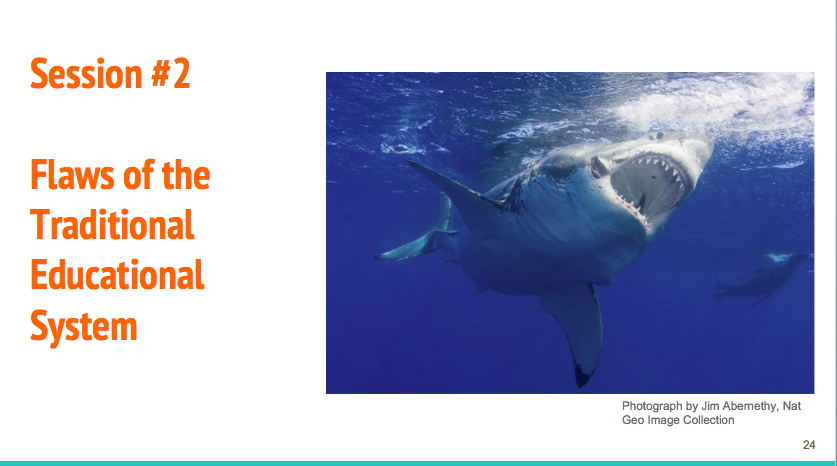
[The following is from an upcoming book on modern schools]
If you don’t learn to understand the nature of the traditional education system, it is going to sneak up and bite you. You’ll have the best design for your school and then without seeing it happen it you’ll suddenly see it dragged back into a form that is consistent with the beliefs of the traditional system.
The core elements of the traditional system was developed primarily between 1845 and 1910. It was a time that our nation was expanding rapidly in terms of its land and the number of people. Horace Mann and other leaders became enamored with the Prussian system and brought much of it back to the U.S. This was at a time that European nations were bumping into each other all the time and war was essentially a constant. Prussian, preparing for this constant tug of war with other European nations, created an education system designed to train young men to join the military. It was highly efficient. Students were organized by age. Teachers all used the same curriculum for each age group and were expected to use the same instructional strategies. And compliance and following the rules was valued as effective armies depend on solders doing as they are told.
Around the turn of the century, there was a push to standardize both the higher education system and the K-12 system. Andrew Carnegie wanted to create a pension system for college faculty. But the first thing that had to happen is decide what a college was. They defined it by what students should know who were admitted to college. They had to have a certain amount of instruction…and they defined it by instructional hours. Thus, the Carnegie unit was born. What’s fascinating is that it was an innovation created in response to a specific problem, pensions for college faculty, and ended up shaping both high schools and colleges. And it’s turned into a terrible obstacle, particularly for higher ed trying to create competency-based programs. About the same time, The Committee of 10 decided that all high schools should offer the same set of courses to all students that were aligned with college expectations. In some ways this might be considered equitable. Everyone has a chance to meet the college admissions expectations. However, it is also inequitable as students that have other interests and career paths are not supported at all. This dynamic continues on today, our state policies say that students should have so many credits in math, english, and so on.
There were many beliefs that shaped the design of the traditional education system. It was believed that intelligence is fixed. It assumed extrinsic motivation worked best. It valued efficiency over effectiveness as it was never designed to have all students learn to high levels. Much of the design is based around the function of schools to rank and sort students. Many of those beliefs continue today and certainly continue to shape education policy and the design of districts and schools. For example, high schools are organized to rank students based on the GPA at the expense of helping all students to learn. They do so by placing more emphasis on summative assessments than formative assessment with opportunity to revise.
To fail to address the beliefs and values that are the foundation of the traditional system is the same as rehabbing a house that is built on a very shaky foundation. Things might be a little bit better, but soon windows won’t be closing properly and water will be leaking into the basement. Similarly if we don’t repair the cracks in the foundation of the traditional system, new and improved instructional programs will flounder, inequity will continue, and students will never be able to discover their fullest potential. They cracks in the foundation are a set of beliefs that were held at the time the traditional system was developed. These beliefs, no longer holding true, undermine the quality of the design and our implementation. We simply can’t get where we want to go with the shaky foundation of the traditional system. The greatest innovation will slip and stumble upon these cracks. So will most students at one time or another.

At CompetencyWorks we identified 10 flaws in the traditional education system that influence learning, growth and achievement. I’ll highlight three of them.
First, as I’ve mentioned, summative assessment is valued at the expense of formative assessment. We simply haven’t designed policies, schedules and calendars, schools or classrooms around the concept of ‘not yet’. Students need to feel safe to take risks in learning, to keep trying. So school culture is important. They need to have productive feedback and opportunity for more instruction, practice and revision. It’s not just time is a variable. It’s about what happens during the flex time.
Second, there is an enormous amount of variability. Students all receive a very similar curriculum but that doesn’t mean that they all learn it to similar levels. At the end of the semester or year they are passed on without opportunity for more instructional support. This has huge implications throughout the system and places the burden on students and teachers. Second, across districts, across schools and even within schools there are different expectations for what proficiency means. The academic standards have been a help to solving this problem but more is necessary including district-wide grading policies and calibration.
Third, false signals, mixed messages and a general sense of fogginess abounds. Students get Bs because they are good students — good attendance, turning things in on time, a generally helpful attitude in the classroom. But they haven’t learned half the material. They may be performing at a lower grade level altogether. But we tell the students and their parents when we give them a B that all is well. I’ve talked to teachers who don’t know what performance level their students are at — they are more focused on the assignments and the curriculum. How can we ever scaffold effectively, how can we have students operating in their zone of proximal development if we don’t’ know where they are in their learning?

Your task is to identify the implications of the flaws of the traditional education system. You will pretend to be making a presentation to an audience of your choice — it could be the school board. It could be another school visiting you. It could be your faculty at an elementary school. You pick an audience that makes sense to you. You have the big paper and markers to create your presentation (and if you want to do power point that’s great — but send it to me or Kristina so we can share it with everyone else). We’ll put them on the walls so we can see each other’s ideas.
Based on where you are in your own learning and implementation there are three options.

Option 1 is for teams where this is all very new. You are going to be focusing on the Why: You are going to create a presentation for when you return back to your school that will help people understand the flaws in the traditional system and aspects of a personalized, competency-based system. You will create a From – To chart with three columns. In the first column list one of the flaws. Feel free to put it in your own terms. In the 2nd column is what you want to repair or replace it with. In the third column describe how this flaw and its replacement relate to the research on learning and achievement.
For this example, I used the flaw high variability and I want to replace it with reliability. Students will put more effort in if they think the system is fair. Reliability helps to build trust whereas high variability can undermine it. And trust is needed for learning. It can improve instruction as well as teachers build up an understanding of what proficiency looks like they will also then finetune instruction and assessment to be aligned with it.
After you do one flaw, pick another one.
Remember, leave time to make your presentation about the implications of the flaws of the traditional system and why it is important. The presentation doesn’t have to be this chart — think about the best way to communicate why its important to understand the traditional system and replace some of its underlying beliefs.

Option 2 is for teams that haven’t started implementation yet you are going to start thinking about the impact on different groups of students and action steps: Again, start by identifying the flaw and the replacement. However, you are going to look for specific examples in your school that relate to the flaw. Think about different groups of students and different ages of students. Then you are going to brainstorm things that could be done to replace it . Again sticking with high variability and reliability, examples might be that lower achieving students or students of color may perceive teachers as being biased against them and that’s why they are getting lower grades. Grading policies may still be based on assignments and not standards. Things you could do to replace it are a transparent framework with the learning objectives, rubrics, and examples of proficiency. You could create a schoolwide grading policy and have teachers calibrate student work.
Again, after you do one, pick another. Leave time to create your presentation about the impact of the traditional system on groups of students and ways to replace it.
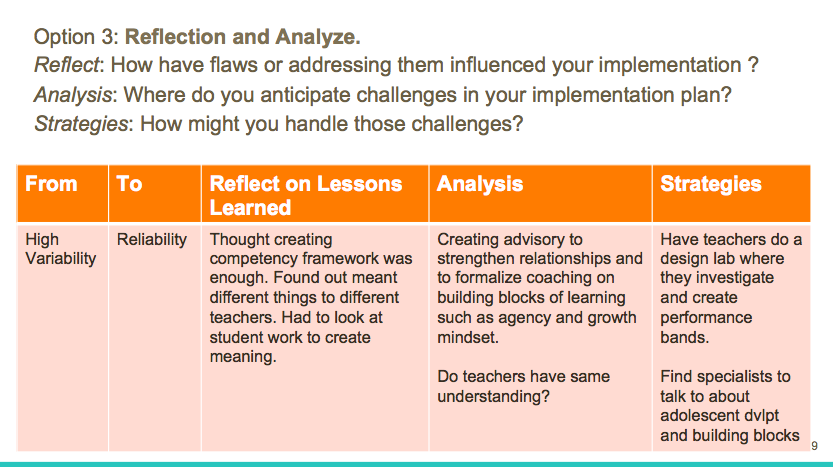
Option 3 is for teams that are implementing their CBE system. You are going to start by picking a flaw and its replacement…and then reflect on how this flaw may have shaped your design and implementation to date. Are there lessons learned? Then you are going to think about your design and implementation steps going forward. Where might the characteristics of the traditional system influence your implementation and which might you do to mitigate it?
Again, starting with high variability, perhaps you created a competency framework with explicit learning targets but found out that it meant different things to different teachers. You may have found out that your fifth grade and your sixth grade teachers had different expectations of what it means to be on grade level. Going forward, you want to have teachers coach students in becoming an empowered learner in advisory. It’s likely that teachers don’t share the same understanding of what that means, how to assess student skills or how to coach. Perhaps you can create a group of teachers to create a design lab to create performance bands. Perhaps you want to hire someone to come in and help instructional coaches understand how to support metacognition in adolescents.
Again, pick your audience for your recommendations of the 3-5 most important lessons learned and changes. And leave time for creating a presentation about your lessons learned and where aspects of the traditional system might influence your implementation strategy.















